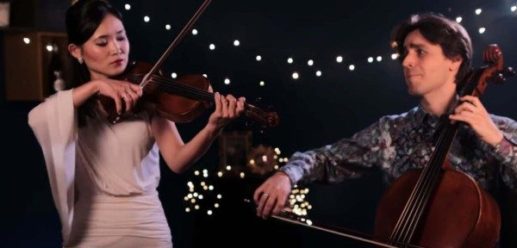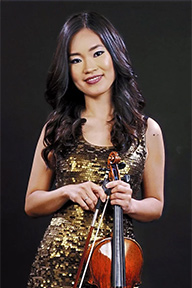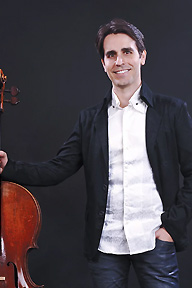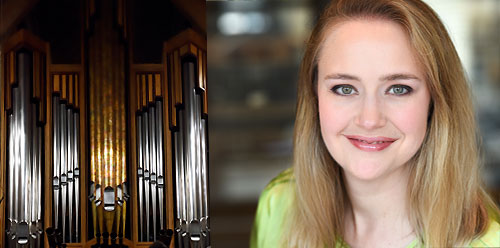DUO-B ~ POSTCARDS FROM SOUTH AMERICA
Thursday, June 9, 2022 | noon
First Presbyterian Church
2408 N. Navarro St.
CARLOS GARDEL (1890-1935)
arr. Hirono Borter
Por una Cabeza
ÁNGEL VILLOLDO (1861-1919)
arr. Hirono Borter
El Choclo
HIRONO BORTER (b. 1976)
Tzigane Tango
Tango Nostalgia
PAUSE
CHIQUINHA GONZAGA (1847-1935)
arr. Hirono Borter
Atraente
ERNESTO NAZARETH (1863-1934)
arr. Hirono Borter
Brejeiro
Odeon
HIRONO BORTER
On My Way
ZEQUINHA DE ABREU (1880-1935)
arr. Hirono Borter
Tico tico no fuba
ASTOR PIAZZOLLA (1921-1992)
arr. Hirono Borter
Three Tangos
- Preparense
- J’attends
- Chau Paris

Sponsors
The Cloyde and Ethel Lee Tracy Foundation
Suzanne & Larry LaBrecque
Anne & Will Wagner
This concert is generously supported by our concert sponsors and by donors to the Victoria Bach Festival’s Annual Fund. Many thanks to our generous supporters!
About the Artists

Hirono Borter, violin
Hirono Borter is a Japanese composer and violinist based in the United States. Alongside her husband, Philip, she formed Duo-B, a violin/cello ensemble dedicated to promoting and expanding the string duo repertory. In addition to performing violin in the duo, Hirono frequently composes and arranges music influenced from a variety of eras and genres. The ensemble’s most recent project included the release of an album of original arrangements of tangos by Astor Piazzolla, which eventually led to concert tours in Italy, Japan, the Midwest, and the Southeastern United States. Hirono is currently engaged composing a series of works, titled Reimagining Bach, taking movements from Johann Sebastian Bach’s solo music and “recomposing” them through the application of modern idioms and popular alternative styles.
In her work with Duo-B, she was recently welcomed as a featured guest artist at the 2019 Experiencing Villa-Lobos: International Festival, the Cedar Valley Chamber Music Festival, the Romanza Festivale in St. Augustine, FL and the 2017 Iowa Composer’s Forum Music in the Shape of a Pear festival.
As a violinist, Hirono has performed across three continents including Austria, France, Germany, Holland, and Italy, Japan, and the US, with landmark performances at Carnegie Hall, the John F. Kennedy Performing Arts Center in Washington D.C., Kodak Hall at the Eastman Theater, Minatomirai Hall in Yokohama, and Tokyo Cultural Hall in Japan. She has collaborated with Ensemble Modern in a performance of the music of Steve Reich in Tokyo, Japan and has also performed with cello soloist Jens Peter Maintz at the Gustav Mahler Akademie in Ferrara, Italy. She completed her Master of Music degree at the Eastman School of Music under Professor Mikhail Kopelman, where she also served as his Teaching Assistant. Earlier studies were conducted at the Hochschule für Musik Freiburg under Professor Latica Honda-Rosenberg and she later received her performance diploma from the Universität der Künste Berlin. Her earliest mentors include Keiko Izumi, Berent Korfker, Gregory Feigin, Yoshio Unno and Zakhar Bron.
In 2020, Hirono and Philip began their own music publishing company, Duo-B Press, dedicated to disseminating more widely musical works written for the violin/cello duo.
Hirono performs on a violin made in 1770 by Italian luthier Pietro Antonio Landolfi.

Philip Borter, cello
Award-winning concert cellist Philip Borter’s performances have taken him across three continents, including appearances in some of the word’s most prestigious venues, with a long list of iconic artists, including Itzak Perlman, Andrea Bocelli, Joshua Bell, Micheal Tilson Thomas, Leonard Slatkin, JoAnn Faletta, among many others. Alongside his wife, Hirono Borter, he formed Duo-B, an ensemble dedicated to works for violin and cello. Together, they were winners of the Eastman Concerto Competition, with landmark performances in Kodak Hall at the Eastman Theater, the John F. Kennedy Performing Arts Center in Washington D.C., the Universität der Künste in Berlin, and Minatomirai Hall in Yokohama, Japan. In his work with Duo-B, Philip was recently welcomed as a featured guest artist at the 2019 Experiencing Villa-Lobos: International Festival, the Cedar Valley Chamber Music Festival, the Romanza Festivale in St. Augustine, FL and the 2017 Iowa Composer’s Forum Music in the Shape of a Pear festival. Other performance projects include a recently released album of Tangos by Astor Piazzolla and concert tours in Italy, Japan, the Midwest, and the Southeastern United States.
Philip has been recognized in both national and international competitions. He was a laureate of the Carlos Prieto International Cello Competition and was also a winner of the Eastman School Concerto Competition and the American String Teachers Association Competition.
Philip completed his Doctor of Musical Arts Degree at the Eastman School of Music, where he was awarded the prestigious Performer’s Certificate. As a student of Steven Doane, he earned his Master of Music Degree at the Eastman School and his Bachelor of Music at the Cleveland Institute of Music under the tutelage of Richard Aaron. Intensive chamber music studies have led to opportunities to work closely with members of the Cavani, Cleveland, Emerson, Miami, Tackas, Tokyo, and Vermeer String Quartets and members of the New York Philharmonic, Metropolitan Opera, Orpheus Chamber Orchestra, National Symphony, and Los Angeles Philharmonic. Other instructors include distinguished pedagogues such as Janos Starker, Joel Krosnick, Eleanor Schoenfeld, and Stephen Geber.
In 2020, Philip joined the faculty of the Baylor University School of Music as Assistant Professor of Cello. He previously taught at Luther College and the University of Rochester.
Philip performs on a cello attributed to Vincenzo Panormo ca. 1790.
“Postcards from South America” offers a journey through two iconic musical styles of Brazil and Argentina: choro and tango. Choro originated in Rio de Janeiro in the late 1800s. In a musical environment that was strongly influenced by African rhythms, choro music developed as Brazilian musicians gained exposure to European musical styles, including the polka. The compositional structure usually has three parts played in rondo form (ABACA) with modulating keys. “Choro” means “cry” or “lament,” but the rhythms and melodies of the genre are generally vibrant and upbeat, shrugging off life’s misfortunes with good humor.
Tango selections from Ángel Villoldo, Carlos Gardel, and Astor Piazzolla on this program represent tango from its earliest days to the nuevo tango style of the late 20th century. Identified with passion and sensuality, tango music developed in Argentina and Uruguay in the late 1800s. Characteristics include the tango rhythm, a 4/4 measure comprised of two dotted quarter notes followed by a quarter note, and the influence of regional folk music and European classical music.
“Por Una Cabeza,” written in 1935 by Carlos Gardel (1917–1935) and popularized in several Hollywood films, is one of the most iconic and well-known tangos. The title comes from the Spanish phrase designating a narrowly won horse race, winning (or losing) “by a head.” The song lyrics, written by Alfredo Le Pera, offer a tragic yet somewhat comedic sentiment, tallying the compulsions and losses of a horse-track gambler, including losing in love. Carlos Gardel transformed from a folk singer into an international sensation of tango music, and helped the form gain a wider audience outside of Argentina.
Known as the “Father of Tango,” Ángel Villoldo (1861-1919) was born just south of Buenos Aires and worked was an actor, composer, lyricist, and singer. The catchy melody and rhythm of his 1903 composition “El Choclo” (“The Corn Cob”) made it one of the most popular tangos in Argentina. The piece was allegedly written in honor of a local nightclub owner, and given his nickname for a title.
Composed by Hirono Borter in 2020, “Tzigane Tango” is a work influenced by both the Argentinian tango and Brazilian choro, while simultaneously channeling the flair of Hungarian Romani music. Like the choro, the music of Eastern Europe shares the experience of informal public encounters while also being fluid in design, instrumentation, and purpose. At the outset, an iconic “gypsy-style” cadenza erupts from the violin, eventually turning to a melancholic descending passage influenced by the harmonic language of Astor Piazzolla. The traditional tango rhythm can be easily noticed throughout in the cello part and, while the violin melodies are still in a gypsy style, the listener might also notice motives more commonly associated with classic rock & roll (another large influence on Hirono). The middle section echoes a more traditional Brazilian choro: cheerful, happy, and light. The subsequent cello solo, which interrupts with a return of the gypsy theme, winds its way back and forth between gypsy and Latin melancholy, only to inevitably return to the opening tango statement.
Borter’s “Tango Nostalgia” (2021) is a work that draws inspiration largely from the nuevo tango style, with both harmonic and formal structures closely resembling Piazzolla’s own “modern” tango genre. The work opens by projecting both a sense of yearning and melancholy, depicting the image of one who left their heart in the past; exhausted with the brokenness of the present. It is as if one was desiring to escape a not unhappy, but complicated, reality, stuck between an idyllic past and an uncertain future. After a short cello solo, the middle section offers a brief flashback to an innocent childhood, of simpler and slower times, which warms the heart. These memories slowly dissolve as reality reimposes itself, recognizing that those memories, while beautiful, are figments. The passacaglia-like cello bass line is unrelenting as the improvisatory violin melody struggles to make sense of it all and find a way to go forward.
Chiquinha Gonzaga (1847-1935) earned a living as a professional pianist, composer, and conductor at a time when Brazilian women were largely confined to domestic pursuits. She composed over 2,000 pieces, including 77 operettas, and her “Grupo Chiquinha Gonzaga” recorded numerous hit records. In 1877, “Atraente” (“Attractive”) appeared as her first published work, designated as a polka. The piece was enormously popular; fifteen editions were published the first year alone. Gonzaga’s sudden popularity was seen as a scandalous provocation by her family, who set out to destroy the music scores sold by boys on the streets.
“Brejeiro,” written in 1893 by Ernesto Júlio de Nazareth (1863-1934), is a charming piece and one of the most popular of what Nazareth called his “Brazilian tangos.” Written for solo piano, “Brejeiro” quickly became a favorite of brass bands and choro ensembles. Nazareth was largely self-taught on the piano. He loved the music of Frederic Chopin, and Chopin’s influence can be heard alongside Brazilian rhythms in a bridge between classical and popular styles. The title “Brejeiro” means “flirtatious,” and this playful piece features syncopation reminiscent of a “cakewalk” in American ragtime, a musical form that was developing at the same time. “Odeon,” written in 1909, takes its title from the luxurious Odeon Cinema in Rio de Janeiro, where Nazareth worked as a pianist from 1920 until 1924.
“On my Way” (2022) is Hirono Borter‘s most recent work and incorporates traits from Brazilian folk traditions. Structurally, the work is closely related to the choro in its rondo form (ABACA) whereby the opening melodic material (stated in the cello part) returns both in the body of the work and at its conclusion. Similarly, the prevalent use of both dotted “skipping” rhythms and 16th note passages gives the work its buoyant and forward-moving feeling. And while the compositional aspects of form and rhythm are borrowed from older traditions, the harmonies are more closely related to modern expressions of the style, influenced particularly by the works of Heitor Villa-Lobos, and the melodic lines employ a sense of freedom popularized by 20th-century writers of the genre.
Since this work, like all purely-instrumental genres, is absent of lyrics, the title “On my Way” is offered as one possible narrative to enjoy the musical arc of the piece. Those three simple words are communicated daily by many to notify loved ones of the conclusion of the workday and the upcoming commute home; the listener can envision a twilight stroll at the opening, with gentle golden rays of light warming up the world around us as we transit. The contrasting middle sections are highly dramatic, reflecting the liveliness of outdoor activities that accompany summer evenings: warm nights filled with families interacting, music-making, and perhaps an occasional burst of unexpected rain that sends everyone scurrying indoors for brief moments. The final return of the relaxed opening material reflects the slow winding-down of the day as, inevitably, energy is exhausted as we make way for rest.
“Tico-Tico no Fubá” is an infectious choro song composed by Zequinha de Abreu (1880-1935) in 1917. Its catchy syncopation and joyful virtuosity made it an enduring international hit, played by musicians as diverse as Carmen Miranda and the Grateful Dead. “Fubá” is a type of corn flour, and “tico-tico” is the name of a sparrow, producing the title “sparrow in the cornmeal.” It’s not difficult to imagine a happy sparrow pecking and spraying cornmeal, or dancers on the dance floor twirling and hopping like happy sparrows.
The leading figure of late 20th-century tango music was Astor Piazzolla (1921-1992). Born near Buenos Aires and raised in New York, Piazzolla learned bandoneón and the tango style at an early age. He later studied classical composition with Argentine composer Alberto Ginastera and with the great French music teacher and composer Nadia Boulanger. “Chau Paris” (“Bye-bye, Paris”) was written after Piazzolla’s studies with Boulanger and was dedicated to Piazzolla’s friend who owned a record shop on the Rue du Louvre.
Piazzolla developed what became known as nuevo tango, which incorporated elements of jazz and modern classical music, including extended harmonies and dissonance, into tango. He also introduced new instruments the ensemble including the flute, saxophone, electric guitar, and a full drum kit. Biographers estimate that Piazzolla wrote around 3,000 pieces and recorded nearly 500.
About the Artists

Hirono Borter, violin
Hirono Borter is a Japanese composer and violinist based in the United States. Alongside her husband, Philip, she formed Duo-B, a violin/cello ensemble dedicated to promoting and expanding the string duo repertory. In addition to performing violin in the duo, Hirono frequently composes and arranges music influenced from a variety of eras and genres. The ensemble’s most recent project included the release of an album of original arrangements of tangos by Astor Piazzolla, which eventually led to concert tours in Italy, Japan, the Midwest, and the Southeastern United States. Hirono is currently engaged composing a series of works, titled Reimagining Bach, taking movements from Johann Sebastian Bach’s solo music and “recomposing” them through the application of modern idioms and popular alternative styles.
In her work with Duo-B, she was recently welcomed as a featured guest artist at the 2019 Experiencing Villa-Lobos: International Festival, the Cedar Valley Chamber Music Festival, the Romanza Festivale in St. Augustine, FL and the 2017 Iowa Composer’s Forum Music in the Shape of a Pear festival.
As a violinist, Hirono has performed across three continents including Austria, France, Germany, Holland, and Italy, Japan, and the US, with landmark performances at Carnegie Hall, the John F. Kennedy Performing Arts Center in Washington D.C., Kodak Hall at the Eastman Theater, Minatomirai Hall in Yokohama, and Tokyo Cultural Hall in Japan. She has collaborated with Ensemble Modern in a performance of the music of Steve Reich in Tokyo, Japan and has also performed with cello soloist Jens Peter Maintz at the Gustav Mahler Akademie in Ferrara, Italy. She completed her Master of Music degree at the Eastman School of Music under Professor Mikhail Kopelman, where she also served as his Teaching Assistant. Earlier studies were conducted at the Hochschule für Musik Freiburg under Professor Latica Honda-Rosenberg and she later received her performance diploma from the Universität der Künste Berlin. Her earliest mentors include Keiko Izumi, Berent Korfker, Gregory Feigin, Yoshio Unno and Zakhar Bron.
In 2020, Hirono and Philip began their own music publishing company, Duo-B Press, dedicated to disseminating more widely musical works written for the violin/cello duo.
Hirono performs on a violin made in 1770 by Italian luthier Pietro Antonio Landolfi.

Philip Borter, cello
Award-winning concert cellist Philip Borter’s performances have taken him across three continents, including appearances in some of the word’s most prestigious venues, with a long list of iconic artists, including Itzak Perlman, Andrea Bocelli, Joshua Bell, Micheal Tilson Thomas, Leonard Slatkin, JoAnn Faletta, among many others. Alongside his wife, Hirono Borter, he formed Duo-B, an ensemble dedicated to works for violin and cello. Together, they were winners of the Eastman Concerto Competition, with landmark performances in Kodak Hall at the Eastman Theater, the John F. Kennedy Performing Arts Center in Washington D.C., the Universität der Künste in Berlin, and Minatomirai Hall in Yokohama, Japan. In his work with Duo-B, Philip was recently welcomed as a featured guest artist at the 2019 Experiencing Villa-Lobos: International Festival, the Cedar Valley Chamber Music Festival, the Romanza Festivale in St. Augustine, FL and the 2017 Iowa Composer’s Forum Music in the Shape of a Pear festival. Other performance projects include a recently released album of Tangos by Astor Piazzolla and concert tours in Italy, Japan, the Midwest, and the Southeastern United States.
Philip has been recognized in both national and international competitions. He was a laureate of the Carlos Prieto International Cello Competition and was also a winner of the Eastman School Concerto Competition and the American String Teachers Association Competition.
Philip completed his Doctor of Musical Arts Degree at the Eastman School of Music, where he was awarded the prestigious Performer’s Certificate. As a student of Steven Doane, he earned his Master of Music Degree at the Eastman School and his Bachelor of Music at the Cleveland Institute of Music under the tutelage of Richard Aaron. Intensive chamber music studies have led to opportunities to work closely with members of the Cavani, Cleveland, Emerson, Miami, Tackas, Tokyo, and Vermeer String Quartets and members of the New York Philharmonic, Metropolitan Opera, Orpheus Chamber Orchestra, National Symphony, and Los Angeles Philharmonic. Other instructors include distinguished pedagogues such as Janos Starker, Joel Krosnick, Eleanor Schoenfeld, and Stephen Geber.
In 2020, Philip joined the faculty of the Baylor University School of Music as Assistant Professor of Cello. He previously taught at Luther College and the University of Rochester.
Philip performs on a cello attributed to Vincenzo Panormo ca. 1790.
Infectious Rhythms: Argentine Tango and Brazilian Choro
“Postcards from South America” offers a journey through two iconic musical styles of Brazil and Argentina: choro and tango. Choro originated in Rio de Janeiro in the late 1800s. In a musical environment that was strongly influenced by African rhythms, choro music developed as Brazilian musicians gained exposure to European musical styles, including the polka. The compositional structure usually has three parts played in rondo form (ABACA) with modulating keys. “Choro” means “cry” or “lament,” but the rhythms and melodies of the genre are generally vibrant and upbeat, shrugging off life’s misfortunes with good humor.
Tango selections from Ángel Villoldo, Carlos Gardel, and Astor Piazzolla on this program represent tango from its earliest days to the nuevo tango style of the late 20th century. Identified with passion and sensuality, tango music developed in Argentina and Uruguay in the late 1800s. Characteristics include the tango rhythm, a 4/4 measure comprised of two dotted quarter notes followed by a quarter note, and the influence of regional folk music and European classical music.
“Por Una Cabeza,” written in 1935 by Carlos Gardel (1917–1935) and popularized in several Hollywood films, is one of the most iconic and well-known tangos. The title comes from the Spanish phrase designating a narrowly won horse race, winning (or losing) “by a head.” The song lyrics, written by Alfredo Le Pera, offer a tragic yet somewhat comedic sentiment, tallying the compulsions and losses of a horse-track gambler, including losing in love. Carlos Gardel transformed from a folk singer into an international sensation of tango music, and helped the form gain a wider audience outside of Argentina.
Known as the “Father of Tango,” Ángel Villoldo (1861-1919) was born just south of Buenos Aires and worked was an actor, composer, lyricist, and singer. The catchy melody and rhythm of his 1903 composition “El Choclo” (“The Corn Cob”) made it one of the most popular tangos in Argentina. The piece was allegedly written in honor of a local nightclub owner, and given his nickname for a title.
Composed by Hirono Borter in 2020, “Tzigane Tango” is a work influenced by both the Argentinian tango and Brazilian choro, while simultaneously channeling the flair of Hungarian Romani music. Like the choro, the music of Eastern Europe shares the experience of informal public encounters while also being fluid in design, instrumentation, and purpose. At the outset, an iconic “gypsy-style” cadenza erupts from the violin, eventually turning to a melancholic descending passage influenced by the harmonic language of Astor Piazzolla. The traditional tango rhythm can be easily noticed throughout in the cello part and, while the violin melodies are still in a gypsy style, the listener might also notice motives more commonly associated with classic rock & roll (another large influence on Hirono). The middle section echoes a more traditional Brazilian choro: cheerful, happy, and light. The subsequent cello solo, which interrupts with a return of the gypsy theme, winds its way back and forth between gypsy and Latin melancholy, only to inevitably return to the opening tango statement.
Borter’s “Tango Nostalgia” (2021) is a work that draws inspiration largely from the nuevo tango style, with both harmonic and formal structures closely resembling Piazzolla’s own “modern” tango genre. The work opens by projecting both a sense of yearning and melancholy, depicting the image of one who left their heart in the past; exhausted with the brokenness of the present. It is as if one was desiring to escape a not unhappy, but complicated, reality, stuck between an idyllic past and an uncertain future. After a short cello solo, the middle section offers a brief flashback to an innocent childhood, of simpler and slower times, which warms the heart. These memories slowly dissolve as reality reimposes itself, recognizing that those memories, while beautiful, are figments. The passacaglia-like cello bass line is unrelenting as the improvisatory violin melody struggles to make sense of it all and find a way to go forward.
Chiquinha Gonzaga (1847-1935) earned a living as a professional pianist, composer, and conductor at a time when Brazilian women were largely confined to domestic pursuits. She composed over 2,000 pieces, including 77 operettas, and her “Grupo Chiquinha Gonzaga” recorded numerous hit records. In 1877, “Atraente” (“Attractive”) appeared as her first published work, designated as a polka. The piece was enormously popular; fifteen editions were published the first year alone. Gonzaga’s sudden popularity was seen as a scandalous provocation by her family, who set out to destroy the music scores sold by boys on the streets.
“Brejeiro,” written in 1893 by Ernesto Júlio de Nazareth (1863-1934), is a charming piece and one of the most popular of what Nazareth called his “Brazilian tangos.” Written for solo piano, “Brejeiro” quickly became a favorite of brass bands and choro ensembles. Nazareth was largely self-taught on the piano. He loved the music of Frederic Chopin, and Chopin’s influence can be heard alongside Brazilian rhythms in a bridge between classical and popular styles. The title “Brejeiro” means “flirtatious,” and this playful piece features syncopation reminiscent of a “cakewalk” in American ragtime, a musical form that was developing at the same time. “Odeon,” written in 1909, takes its title from the luxurious Odeon Cinema in Rio de Janeiro, where Nazareth worked as a pianist from 1920 until 1924.
“On my Way” (2022) is Hirono Borter‘s most recent work and incorporates traits from Brazilian folk traditions. Structurally, the work is closely related to the choro in its rondo form (ABACA) whereby the opening melodic material (stated in the cello part) returns both in the body of the work and at its conclusion. Similarly, the prevalent use of both dotted “skipping” rhythms and 16th note passages gives the work its buoyant and forward-moving feeling. And while the compositional aspects of form and rhythm are borrowed from older traditions, the harmonies are more closely related to modern expressions of the style, influenced particularly by the works of Heitor Villa-Lobos, and the melodic lines employ a sense of freedom popularized by 20th-century writers of the genre.
Since this work, like all purely-instrumental genres, is absent of lyrics, the title “On my Way” is offered as one possible narrative to enjoy the musical arc of the piece. Those three simple words are communicated daily by many to notify loved ones of the conclusion of the workday and the upcoming commute home; the listener can envision a twilight stroll at the opening, with gentle golden rays of light warming up the world around us as we transit. The contrasting middle sections are highly dramatic, reflecting the liveliness of outdoor activities that accompany summer evenings: warm nights filled with families interacting, music-making, and perhaps an occasional burst of unexpected rain that sends everyone scurrying indoors for brief moments. The final return of the relaxed opening material reflects the slow winding-down of the day as, inevitably, energy is exhausted as we make way for rest.
“Tico-Tico no Fubá” is an infectious choro song composed by Zequinha de Abreu (1880-1935) in 1917. Its catchy syncopation and joyful virtuosity made it an enduring international hit, played by musicians as diverse as Carmen Miranda and the Grateful Dead. “Fubá” is a type of corn flour, and “tico-tico” is the name of a sparrow, producing the title “sparrow in the cornmeal.” It’s not difficult to imagine a happy sparrow pecking and spraying cornmeal, or dancers on the dance floor twirling and hopping like happy sparrows.
The leading figure of late 20th-century tango music was Astor Piazzolla (1921-1992). Born near Buenos Aires and raised in New York, Piazzolla learned bandoneón and the tango style at an early age. He later studied classical composition with Argentine composer Alberto Ginastera and with the great French music teacher and composer Nadia Boulanger. “Chau Paris” (“Bye-bye, Paris”) was written after Piazzolla’s studies with Boulanger and was dedicated to Piazzolla’s friend who owned a record shop on the Rue du Louvre.
Piazzolla developed what became known as nuevo tango, which incorporated elements of jazz and modern classical music, including extended harmonies and dissonance, into tango. He also introduced new instruments the ensemble including the flute, saxophone, electric guitar, and a full drum kit. Biographers estimate that Piazzolla wrote around 3,000 pieces and recorded nearly 500.




